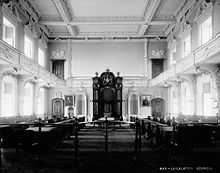Legislative Council of Quebec
| Legislative Council of Quebec Conseil législatif du Québec | |
|---|---|
| Type | |
| Type |
Upper house of the Quebec Legislature |
| History | |
| Founded | July 1, 1867 |
| Disbanded | December 31, 1968 |
| Preceded by | Legislative Council of the Province of Canada |
| Succeeded by | none |

From 1867 until 1968, the Legislative Council of Quebec (French; Conseil législatif du Québec) was the unelected upper house of the bicameral legislature in the Canadian province of Quebec. The Legislative Assembly was the elected lower house.
The Council was composed of 24 members, appointed by the Lieutenant Governor upon recommendation of the Premier. Each councillor nominally represented a portion of the Province of Quebec called a division. The boundaries of these divisions were identical to the ones used for Canada East by the Legislative Council of the Province of Canada and were also identical to the boundaries still used today by the Senate of Canada for Quebec. The division boundaries were never changed to accommodate the territorial expansion of Quebec in 1898 and 1912.
Members were originally appointed for life. In 1963 the rule was changed to force members to retire at age 75, but this did not apply to already-appointed members. In the event, the change remained entirely theoretical since the Council was abolished before it could be applied to anyone.
The Council had the right to introduce bills, except of a financial nature, and to amend or veto bills passed by the Legislative Assembly. Its speaker, known in French as Orateur, was by right a member of the Cabinet, and its members could serve as ministers or even Premier. Two Quebec premiers, Charles-Eugène Boucher de Boucherville and John Jones Ross were members of the Legislative Council.

Effective December 31, 1968 the Legislative Council was abolished, and the Legislative Assembly of Quebec was renamed the National Assembly.[1] As a consequence, Quebec has a unicameral legislature. The establishment of the original system dates back to the Constitutional Act of 1791.
The Union Nationale government of Premier Jean-Jacques Bertrand passed the legislation, known as "Bill 90", to implement the change. Previous governments had made unsuccessful attempts to eliminate the upper chamber. In fact, the first attempt dated all the way back to Félix-Gabriel Marchand in the late nineteenth century. Quebec was the last Canadian province to abolish its upper house.
The large chamber which used to house the Legislative Council is also known in French as le salon rouge (the red hall) and in English as "the Red Room" because of the predominance of this colour on the walls. It is now used for committee meetings and for important state functions that require a large, impressive hall, such as inductions into the National Order of Quebec.
When it was dissolved the standings were: Union Nationale - 15, Liberal - 9.
Speakers of the Legislative Council of Quebec (1867–1968)
- Charles-Eugène Boucher de Boucherville 1867–1873
- John Jones Ross 1873–1874
- Félix-Hyacinthe Lemaire 1874–1876
- John Jones Ross 1876–1878
- Henry Starnes 1878–1879
- John Jones Ross 1879–1882
- Pierre Boucher de la Bruère 1882–1889
- Henry Starnes 1889–1892
- Pierre Boucher de la Bruère 1892–1895
- Thomas Chapais 1895–1897
- Vildebon-Winceslas Larue 1897
- Horace Archambeault 1897–1909
- Adélard Turgeon 1909–1930
- Jacob Nicol 1930–1934
- Hector Laferté 1934–1936
- Alphonse Raymond 1936–1940
- Hector Laferté 1940–1944
- Alphonse Raymond 1944–1950
- Jean-Louis Baribeau 1950–1960
- Hector Laferté 1960–1966
- Jean-Louis Baribeau 1966–1968
Members of the Legislative Council
See also
References
- ↑ "L’Assemblée législative devient l’Assemblée nationale: 31 décembre 1968". Révolution tranquille (in French). Government of Quebec. Retrieved February 19, 2012.